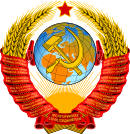Journalism is the production and distribution of reports on the interaction of events, facts, ideas, and people that are the "news of the day" and that informs society to at least some degree of accuracy. The word, a noun, applies to the occupation, the methods of gathering information, and the organizing literary styles.
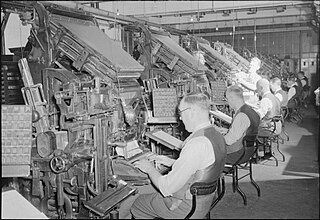
The history of British newspapers begins in the 17th century with the emergence of regular publications covering news and gossip. The relaxation of government censorship in the late 17th century led to a rise in publications, which in turn led to an increase in regulation throughout the 18th century. The Times began publication in 1785 and became the leading newspaper of the early 19th century, before the lifting of taxes on newspapers and technological innovations led to a boom in newspaper publishing in the late 19th century. Mass education and increasing affluence led to new papers such as the Daily Mail emerging at the end of the 19th century, aimed at lower middle-class readers.
The mass media in Communist Czechoslovakia was controlled by the Communist Party of Czechoslovakia (KSČ). Private ownership of any publication or agency of the mass media was generally forbidden, although churches and other organizations published small periodicals and newspapers. Even with this informational monopoly in the hands of organizations under KSČ control, all publications were reviewed by the government's Office for Press and Information. Censorship was lifted for three months during the 1968 Prague Spring but afterward was reimposed under the terms of the 1966 Press Law. The law states that the Czechoslovak press is to provide complete information, but it must also advance the interests of socialist society and promote the people's socialist awareness of the policy of the communist party as the leading force in society and state.

Izvestia is a daily broadsheet newspaper in Russia. Founded in February 1917, Izvestia, which covered foreign relations, was the organ of the Supreme Soviet of the Soviet Union, disseminating official state propaganda. It is now described as a "national newspaper" of Russia.

A letter to the editor (LTE) is a letter sent to a publication about an issue of concern to the reader. Usually, such letters are intended for publication. In many publications, letters to the editor may be sent either through conventional mail or electronic mail.
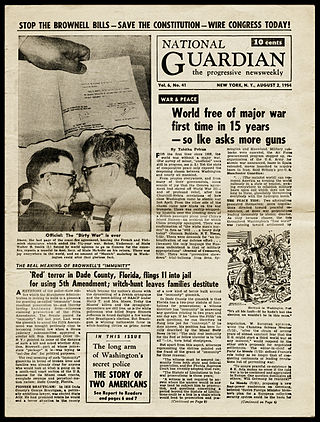
The National Guardian, later known as The Guardian, was a left-wing independent weekly newspaper established in 1948 in New York City. The paper was founded by James Aronson, Cedric Belfrage and John T. McManus in connection with the 1948 Presidential campaign of Henry A. Wallace under the Progressive Party banner. Although independent and often critical of all political parties, the National Guardian is thought to have been initially close to the ideological orbit of the pro-Moscow Communist Party USA, but this suspected association quickly broke down in the course of several years.

The history of American newspapers begins in the early 18th century with the publication of the first colonial newspapers. American newspapers began as modest affairs—a sideline for printers. They became a political force in the campaign for American independence. Following independence the first amendment to U.S. Constitution guaranteed freedom of the press. The Postal Service Act of 1792 provided substantial subsidies: Newspapers were delivered up to 100 miles for a penny and beyond for 1.5 cents, when first class postage ranged from six cents to a quarter.
Southern Weekly is a Chinese weekly newspaper based in Guangzhou, and is a sister publication of the newspaper Nanfang Daily.
As with many Soviet-allied countries prior to the fall of the Berlin Wall, the government of the former German Democratic Republic applied censorship during its existence from 1949 to 1990. The censorship was practised through a hierarchical but unofficial censorship apparatus, ultimately controlled by the ruling party (SED). Through censorship, the socialist point of view on society was ensured in all forms of literature, arts, culture and public communication. Due to the lack of an official censorship apparatus, censorship was applied locally in a highly structured and institutionalized manner under the control of the SED.
The history of journalism spans the growth of technology and trade, marked by the advent of specialized techniques for gathering and disseminating information on a regular basis that has caused, as one history of journalism surmises, the steady increase of "the scope of news available to us and the speed with which it is transmitted". Before the printing press was invented, word of mouth was the primary source of news. Returning merchants, sailors, travelers brought news back to the mainland, and this was then picked up by pedlars and traveling players and spread from town to town. Ancient scribes often wrote this information down. This transmission of news was highly unreliable and died out with the invention of the printing press. Newspapers have always been the primary medium of journalists since the 18th century, radio and television in the 20th century, and the Internet in the 21st century.

The modern newspaper is a European invention. The oldest direct handwritten news sheets circulated widely in Venice as early as 1566. These weekly news sheets were full of information on wars and politics in Italy and Europe. The first printed newspapers were published weekly in Germany from 1605. Typically, they were censored by the government, especially in France, and reported mostly foreign news and current prices. After the English government relaxed censorship in 1695, newspapers flourished in London and a few other cities including Boston and Philadelphia. By the 1830s, high-speed presses could print thousands of papers cheaply, allowing low daily costs.
People's correspondents were amateur worker peasant and journalists since the early years of the Soviet Union. Originally initiated by Vladimir Lenin as a tool for exposing mismanagement and corruption, several million people worked as people's correspondents in their heyday. At the 17th Party Congress in 1934, Joseph Stalin said there were more than 3 million worker and peasant correspondents.
Bednota was a daily newspaper designed and focused toward a peasant readership that was issued by the Central Committee of the Communist Party of the Soviet Union in Moscow, Russia, from March 1918 to January 1931. It has been described as the first Soviet newspaper "designed primarily for the lower-class or common reader".

Golos Truda was a Russian-language anarchist newspaper. Founded by working-class Russian expatriates in New York City in 1911, Golos Truda shifted to Petrograd during the Russian Revolution in 1917, when its editors took advantage of the general amnesty and right of return for political dissidents. There, the paper integrated itself into the anarchist labour movement, pronounced the necessity of a social revolution of and by the workers, and situated itself in opposition to the myriad of other left-wing movements.
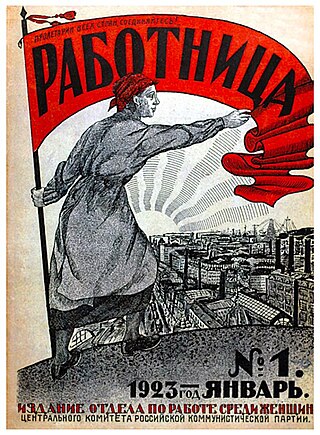
Rabotnitsa is a women's journal, published in the Soviet Union and Russia and one of the oldest Russian magazines for women and families. Founded in 1914, and first published on Women's Day, it is the first socialist women's journal, and the most politically left of the women's periodicals. While the journal's beginnings are attributed to Lenin and several women who were close to him, he did not contribute to the first seven issues.

Newspapers have played a major role in French politics, economy and society since the 17th century.
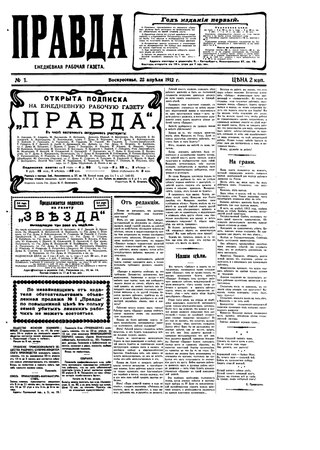
Pravda is a Russian broadsheet newspaper, and was the official newspaper of the Central Committee of the Communist Party of the Soviet Union, when it was one of the most influential papers in the country with a circulation of 11 million. The newspaper began publication on 5 May 1912 in the Russian Empire but was already extant abroad in January 1911. It emerged as the leading government newspaper of the Soviet Union after the October Revolution. The newspaper was an organ of the Central Committee of the CPSU between 1912 and 1991. After the dissolution of the Soviet Union, Pravda was sold by the then Russian president Boris Yeltsin to a Greek business family in 1992, and the paper came under the control of their private company Pravda International.
The history of journalism in the United Kingdom includes the gathering and transmitting of news, spans the growth of technology and trade, marked by the advent of specialised techniques for gathering and disseminating information on a regular basis. In the analysis of historians, it involves the steady increase of the scope of news available to us and the speed with which it is transmitted.
The history of Russian journalism covers writing for newspapers, magazines, and electronic media since the 18th century. The main themes are low levels of literacy, censorship and government control, and the emphasis on politics and political propaganda in the media.
Censorship in Vietnam is pervasive and is implemented by the Communist Party of Vietnam (CPV) in relation to all kinds of media – the press, literature, works of art, music, television and the Internet. The government censors content for mainly political reasons, such as curtailing political opposition, and censoring events unfavorable to the party. In its 2021 Press Freedom Index, the Reporters Without Borders (RSF) ranked Vietnam as "very serious" at 174 out of 180 countries, one of the lowest in the world and the worst ranking on their five-point scale. Similarly, Freedom House's 2021 Freedom on the Net report classifies Vietnam as "not free" in relation to the Internet, with significant obstacles to access, limits on content and significant violations of user rights.
